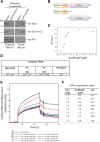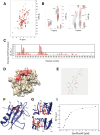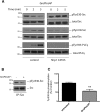A signalling cascade involving receptor-activated phospholipase A2, glycerophosphoinositol 4-phosphate, Shp1 and Src in the activation of cell motility
- PMID: 30823936
- PMCID: PMC6396489
- DOI: 10.1186/s12964-019-0329-3
A signalling cascade involving receptor-activated phospholipase A2, glycerophosphoinositol 4-phosphate, Shp1 and Src in the activation of cell motility
Abstract
Background: Shp1, a tyrosine-phosphatase-1 containing the Src-homology 2 (SH2) domain, is involved in inflammatory and immune reactions, where it regulates diverse signalling pathways, usually by limiting cell responses through dephosphorylation of target molecules. Moreover, Shp1 regulates actin dynamics. One Shp1 target is Src, which controls many cellular functions including actin dynamics. Src has been previously shown to be activated by a signalling cascade initiated by the cytosolic-phospholipase A2 (cPLA2) metabolite glycerophosphoinositol 4-phosphate (GroPIns4P), which enhances actin polymerisation and motility. While the signalling cascade downstream Src has been fully defined, the mechanism by which GroPIns4P activates Src remains unknown.
Methods: Affinity chromatography, mass spectrometry and co-immunoprecipitation studies were employed to identify the GroPIns4P-interactors; among these Shp1 was selected for further analysis. The specific Shp1 residues interacting with GroPIns4P were revealed by NMR and validated by site-directed mutagenesis and biophysical methods such as circular dichroism, isothermal calorimetry, fluorescence spectroscopy, surface plasmon resonance and computational modelling. Morphological and motility assays were performed in NIH3T3 fibroblasts.
Results: We find that Shp1 is the direct cellular target of GroPIns4P. GroPIns4P directly binds to the Shp1-SH2 domain region (with the crucial residues being Ser 118, Arg 138 and Ser 140) and thereby promotes the association between Shp1 and Src, and the dephosphorylation of the Src-inhibitory phosphotyrosine in position 530, resulting in Src activation. As a consequence, fibroblast cells exposed to GroPIns4P show significantly enhanced wound healing capability, indicating that GroPIns4P has a stimulatory role to activate fibroblast migration. GroPIns4P is produced by cPLA2 upon stimulation by diverse receptors, including the EGF receptor. Indeed, endogenously-produced GroPIns4P was shown to mediate the EGF-induced cell motility.
Conclusions: This study identifies a so-far undescribed mechanism of Shp1/Src modulation that promotes cell motility and that is dependent on the cPLA2 metabolite GroPIns4P. We show that GroPIns4P is required for EGF-induced fibroblast migration and that it is part of a cPLA2/GroPIns4P/Shp1/Src cascade that might have broad implications for studies of immune-inflammatory response and cancer.
Keywords: Actin polymerisation; Cell motility; EGF; Glycerophosphoinositols; Membrane ruffles; Phosphoinositides; SH2 domain; Shp1.
Conflict of interest statement
Ethics approval and consent to participate
Not applicable.
Consent for publication
Not applicable.
Competing interests
The authors declare that they have no competing interests.
Publisher’s Note
Springer Nature remains neutral with regard to jurisdictional claims in published maps and institutional affiliations.
Figures








Similar articles
-
The phosphatase Shp1 interacts with and dephosphorylates cortactin to inhibit invadopodia function.Cell Commun Signal. 2021 Jun 4;19(1):64. doi: 10.1186/s12964-021-00747-6. Cell Commun Signal. 2021. PMID: 34088320 Free PMC article.
-
SRC-dependent signalling regulates actin ruffle formation induced by glycerophosphoinositol 4-phosphate.Biochim Biophys Acta. 2008 Dec;1783(12):2311-22. doi: 10.1016/j.bbamcr.2008.07.021. Epub 2008 Aug 3. Biochim Biophys Acta. 2008. PMID: 18722484
-
Membrane transport and in vitro metabolism of the Ras cascade messenger, glycerophosphoinositol 4-phosphate.Eur J Biochem. 1999 Dec;266(2):413-9. doi: 10.1046/j.1432-1327.1999.00870.x. Eur J Biochem. 1999. PMID: 10561581
-
Glycerophosphoinositols as potential markers of ras-induced transformation and novel second messengers.Anticancer Res. 1996 May-Jun;16(3B):1341-50. Anticancer Res. 1996. PMID: 8694500 Review.
-
Growth factor-dependent phosphoinositide signalling.Int J Biochem Cell Biol. 1997 Mar;29(3):415-35. doi: 10.1016/s1357-2725(96)00163-x. Int J Biochem Cell Biol. 1997. PMID: 9202421 Review.
Cited by
-
Direct LC-MS/MS Analysis of Extra- and Intracellular Glycerophosphoinositol in Model Cancer Cell Lines.Front Immunol. 2021 Mar 2;12:646681. doi: 10.3389/fimmu.2021.646681. eCollection 2021. Front Immunol. 2021. PMID: 33737939 Free PMC article.
-
The phosphatase Shp1 interacts with and dephosphorylates cortactin to inhibit invadopodia function.Cell Commun Signal. 2021 Jun 4;19(1):64. doi: 10.1186/s12964-021-00747-6. Cell Commun Signal. 2021. PMID: 34088320 Free PMC article.
-
Glycerophosphoinositol Promotes Apoptosis of Chronic Lymphocytic Leukemia Cells by Enhancing Bax Expression and Activation.Front Oncol. 2022 Mar 22;12:835290. doi: 10.3389/fonc.2022.835290. eCollection 2022. Front Oncol. 2022. PMID: 35392232 Free PMC article.
-
Cytosolic Phospholipase A2 Alpha Regulates TLR Signaling and Migration in Metastatic 4T1 Cells.Int J Mol Sci. 2019 Sep 27;20(19):4800. doi: 10.3390/ijms20194800. Int J Mol Sci. 2019. PMID: 31569627 Free PMC article.
-
Shp1 in Solid Cancers and Their Therapy.Front Oncol. 2020 Jun 11;10:935. doi: 10.3389/fonc.2020.00935. eCollection 2020. Front Oncol. 2020. PMID: 32596156 Free PMC article. Review.
References
-
- Valitutti S, Cucchi P, Colletta G, Di Filippo C, Corda D. Transformation by the k-ras oncogene correlates with increases in phospholipase A2 activity, glycerophosphoinositol production and phosphoinositide synthesis in thyroid cells. Cell Signal. 1991;3:321–332. doi: 10.1016/0898-6568(91)90061-X. - DOI - PubMed
-
- Mariggio S, Sebastia J, Filippi BM, Iurisci C, Volonte C, Amadio S, De Falco V, Santoro M, Corda D. A novel pathway of cell growth regulation mediated by a PLA2alpha-derived phosphoinositide metabolite. The FASEB journal : official publication of the Federation of American Societies for Experimental Biology. 2006;20:2567–2569. doi: 10.1096/fj.05-5397fje. - DOI - PubMed
-
- Corda D, Falasca M. Glycerophosphoinositols as potential markers of ras-induced transformation and novel second messengers. Anticancer Res. 1996;16:1341–1350. - PubMed
Publication types
MeSH terms
Substances
Grants and funding
LinkOut - more resources
Full Text Sources
Molecular Biology Databases
Research Materials
Miscellaneous

